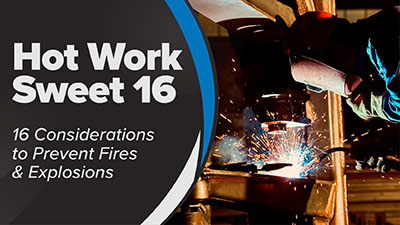Hot Work Considerations: The Sweet 16
Fires and explosions caused by Hot Work are preventable. Establishing a strong Hot Work fire prevention program is a must for every manager responsible for fire and life safety at industrial facilities, construction sites, and commercial repair locations.
What is Hot Work?
According to the 2019 Edition of NFPA (National Fire Protection Association) 51B, Standard for Fire Prevention During Welding, Cutting, and Other Hot Work, Hot Work involves “burning, welding, or a similar operation that is capable of initiating fires or explosions.” (Please note: the next revision of NFPA 51B is expected mid-2023).
A few examples of Hot Work include torch or radial-saw cutting, welding, brazing, soldering, grinding, and torch-applied roof covering.
Hot Work and Fire Loss
No one is immune from fire loss due to Hot Work – for example, if you are a general manager or in charge of health and safety at a small, mid-size or large manufacturing or other type of industrial facility, calling in an outside contractor for even a small repair of process equipment or a building structural component could present significant risk.
According to NFPA research estimates, in the United States alone, fire departments respond to an average of 4,580 structure fires involving hot work each year with 57% of incidents occurring in non-residential settings, with an average of 22 civilian deaths, 171 civilian injuries, and $484 million in property damage incurred.
On August 4, 2020, a devastating fire and subsequent explosion caused by Hot Work occurred at the Port of Beirut. Hot Work—welding—ignited stored fireworks and ammonium nitrate. The result: 218 were killed, more than 7,000 were injured, over 70,000 apartments were impacted, and at least 300,000 residents were forced to look for housing. The World Bank estimated the cost of the incident at $3.8 to $4.6 Billion.
What are the Primary Elements of an Effective Hot Work Fire Prevention Program?
Effective Hot Work management requires policy, procedures, and trained personnel. Senior level management must support the Hot Work program. Here are some considerations:
- Establish a formal Hot Work Program for the facility. This includes a Hot Work Permit system that establishes a qualified Permit Authorizing Individual.
- Provide training for the Permit Authorizing Individual and all employees or contractors performing Hot Work. The NFPA has an on-line Hot Work training program. Hot Work Safety Certificate Online Training (nfpa.org)
- Maintain a robust Hot Work Permit, one that is up to date with current codes and standards.
- Train employees and contractors on facility-specific fire and explosion hazards.
- Based on conditions at your facility, identify those specific areas where Hot Work is permissible but requires a Hot Work permit, not permissible under any circumstances (due to extreme hazard), permissible without a Hot Work permit, such as a pre-approved for Hot Work non-combustible workshop area
- See if you can eliminate the need to conduct Hot Work by establishing if the operation or repair can be done using an alternative Cold Work method such as bolting or clamping.
- Always ask: Can the Hot Work be conducted in a designated area identified and maintained as non-combustible, such as a pre-approved for Hot Work workshop area, where the issuance of a Hot Work permit will not be necessary?
- Always properly prepare and maintain Hot Work areas by eliminating combustible, ignitable, or flammable materials from the area. If combustibles cannot be removed, cover them with approved fire blankets or pads.
- Prior to approval, the Permit Authorizing Individual needs to do a walk-through of the Hot Work area, as a second set of eyes, to verify conditions are proper for Hot Work, as indicated on the Permit by the requestor. This acts as a second risk assessment for Hot Work activity.
- The Permit Authorizing Individual needs to verify that the facility’s built-in fire protection features, such as fire sprinkler or special gaseous agent suppression systems are fully operational prior to Hot Work.
- Always test equipment and/or piping and tanks for the presence of flammable and combustible vapor and gas prior to the start of Hot Work activity, even if the equipment normally does not contain these materials.
- Provide uninterrupted Fire Watch for the Hot Work area, start to finish. Maintain Fire Watch during breaks in Hot Work activity and post Hot Work. Maintain Fire Monitoring after Fire Watch ends.
- Make sure fire watch understands he/she is responsible for and knows how to transmit an alarm of fire; and recognizes the need to immediately, without delay, call the fire department emergency phone number from the Hot Work area, should a fire develop.
- Always supply the correct quantity, types and sizes of portable fire extinguishers, water hose lines, and foam-based fire suppression equipment both at and near the Hot Work area. This will avoid delay should an incipient first-aid fire response by employees become required.
- Employees who conduct Hot Work and Fire Watch need prior training and must be competent in the use of incipient fire suppression devices, including portable fire extinguishers and hose lines. Training also needs to include how to identify fire conditions beyond incipient and understand the need to evacuate the area.
- Identify at least two means of emergency egress from the Hot Work area and make sure employees recognize these exits as an escape plan.
Summary
Many issues need to be addressed to provide an environment for Hot Work activity that has a minimized level of risk. Large portions of risk can be engineered out of the activity by using up-to-date policies, procedures and training that adheres to current codes, standards, and industry best practices.
Want to get more in depth with your Hot Work Safety? You can purchase the NFPA’s 51B Hot Work Safety Toolkit on their website!
